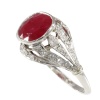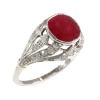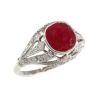Nu gespreide betaling mogelijk op het juweel van uw dromen! Vraag ons naar de details. Gratis verzekerde verzending van alle orders!
Bestellingen zullen behandeld worden vanaf maandag 25 augustus.
Burmese Ruby and Diamond Deco Dream Ring
A platinum French Art Deco treasure, circa 1920, holds a bewitching dance of light and shadow with a central 3.19ct natural Burmese ruby, embraced by 30 old brilliant and single-cut diamonds. With origins in France, this ring is a seamless blend between the Art Deco and the Belle Époque periods, capturing the essence of early 20th-century glamour. A celebration of love’s eternity, perfect for an engagement or an anniversary, it is a piece of history awaiting its continuation in a new chapter.
Antique jewelry object group: engagement ring (or anniversary ring)
Condition: good condition
- (more info on our condition scale)
Country of origin:
France
Style:
Something between Art Deco and Belle Époque - Art Deco is an eclectic artistic and design style which had its origins in Paris in the first decades of the 20th century. The style originated in the 1920s and continued to be employed until after
World War II. The term "art deco" first saw wide use after an exhibition in 1966, referring to the 1925 Exposition Internationale des Arts Décoratifs et Industriels Modernes that was the culmination of high-end style modern in Paris. Led by the
best designers in the decorative arts such as fashion, and interior design, Art Deco affected all areas of design throughout the 1920s and 1930s, including architecture and industrial design, as well as the visual arts such as painting, the graphic arts
and film. At the time, this style was seen as elegant, glamorous, functional and modern. - See also: Art Deco.
And the Belle Époque (French for "Beautiful Era") was a period in European social history that began during the late 19th century and lasted until World War I. Occurring during the time of the French Third Republic and the German Empire, the
"Belle Époque" was named in retrospect, when it began to be considered a "golden age" the major powers of Europe, new technologies improved lives and the commercial arts adapted Renaissance and eighteenth-century styles to modern forms. In the
newly rich United States, emerging from the Panic of 1873, the comparable epoch was dubbed the Gilded Age. In the United Kingdom, this epoch overlaps the end of what is called the Victorian Era there and the period named the Edwardian Era.
or more info on styles
Style specifics: This is something between Belle Époque and Art Deco.
The Belle Époque
(French for "Beautiful Era") was a period in European social history that began during the late 19th century from the Franco-Prussian War (1870-1871) and lasted until World War I (1914-18).
Occurring during the time of the French Third Republic and the German Empire, the "Belle Époque" was named in retrospect, when it began to be considered a "golden age" the major powers of Europe, new technologies improved lives and the commercial
arts adapted Renaissance and eighteenth-century styles to modern forms.
In the newly rich United States, emerging from the Panic of 1873, the comparable epoch was dubbed the Gilded Age. In the United Kingdom, this epoch overlaps the end of what is called the Victorian Era there and the period named the Edwardian Era.
In the Belle Époque cheap coal and cheap labour contributed to the cult of the orchid and made possible the perfection of fruits grown under glass, as the apparatus of state dinners extended to the upper classes; champagne was perfected during the
Belle Époque. Exotic feathers and furs were more prominently featured in fashion than ever before, as haute couture was invented in Paris, the centre of the Belle Époque, where fashion began to move in a yearly cycle; in Paris restaurants
such as Maxim's achieved a new splendour and cachet as places for the rich to parade, and the Opéra Garnier devoted enormous spaces to staircases as similar show places.
After mid-century, railways linked all the major cities of Europe to spa towns like Biarritz and Deauville; their carriages were rigorously divided into first-class and second-class, but the super-rich now began to commission private railway coaches, as
exclusivity was a hallmark of opulent luxury. Bohemian lifestyles gained a different glamour, pursued in the cabarets of Montmartre.
Art Deco
Abstract motives and geometrical forms are quite typical for the Art Deco period. Art Deco moved away from the soft pastels and organic forms of its style predecessor, Art Nouveau, and embraced influences from many different styles and movements of the
early 20th century, including Neoclassical, Constructivism, Cubism, Modernism, and Futurism. Its popularity peaked in Europe during the Roaring Twenties and continued strongly in the United States through the 1930s. Although many design movements have
political or philosophical roots or intentions, Art Deco was purely decorative.
Period: ca. 1920
- (events & facts of this era, poetry of this era,
fashion of this era)
Material: platinum
- (more info on precious metals)
Extra information:
Betrothal rings were used during Roman times, but weren't generally revived in the Western world until the 13th century. The first well-documented use of a diamond ring to signify engagement was by the Archduke Maximilian of Austria in imperial court of
Vienna in 1477, upon his betrothal to Mary of Burgundy.
Before the 20th century, other types of betrothal gifts were common. Before the end of the 19th century, the bride-to-be frequently received a sewing thimble rather than a engagement ring. This practice was particularly common among religious groups that
shunned jewelry. Engagement rings didn't become standard in the West until the end of the 19th century, and diamond rings didn't become common until the 1930s. Now, 80% of the women are offered a diamond ring to signify engagement. (from: Wikipedia)
Diamond(s):
30
old brilliant cut diamonds
and single brilliant cut diamonds (also called 8/8)
with an estimated weight of ± 0.50ct.
(colour and clarity: F/J, vs/i).
- All diamond weights, color grades and clarity are approximate since the stones were not removed from their mounts to preserve the integrity of the setting.
Total diamond weight: approx. 0.50 crt.
Precious stones:
One
natural Burmese ruby (see pictures for certificate)
with a weight of 3.19ct., Purplish red, semi-translucent, origin Mong Hsu (Myanmar, former Burma)
Treatment: heat treated, natural rubies are commonly enhanced by a thermal process. This is an accepted technique as long as it is mentioned by the seller.
Birthstones:
Ruby is the birthstone (or month stone) for July
and diamond for April.
- (more info on birthstones)
Hallmarks: The French control mark representing a "mascaron" (French for "grotesque mask") that was in use in France from 1912 and used for into France imported platinum jewelry and objects.
- (more info on hallmarks)
Dimensions: width of top of ring 1,18 cm (0,46 inch)
Weight: 4,50 gram (2,89 dwt)
Ring size Continental: 52 & 16½ , Size US 6 , Size UK: L
Resizing: Free resizing, but because of the the way the ring is made, we cannot guarantee to make it on every size; so please ask in advance (only for extreme resizing we have to charge).
- (more info on ring sizes)
Reference Nº: 16319-0014
Copyright photography: Adin, fine antique jewelry
platinum jewelry,
jewelry with ruby,
jewelry with diamond,
latest acquisitions,
antique jewelry,
estate jewelry,
vintage jewelry or
modern jewelry
Jewelry with birthstones (or month stones) for:
January -
February -
March -
April -
May -
June -
July
August -
September -
October -
November or
December.
Additional information:
jewelry glossary -
wall of fame -
visit us in Antwerp -
subscribe to our mailinglist.
What is antique jewelry? -
What is estate jewelry? -
What is vintage jewelry?























